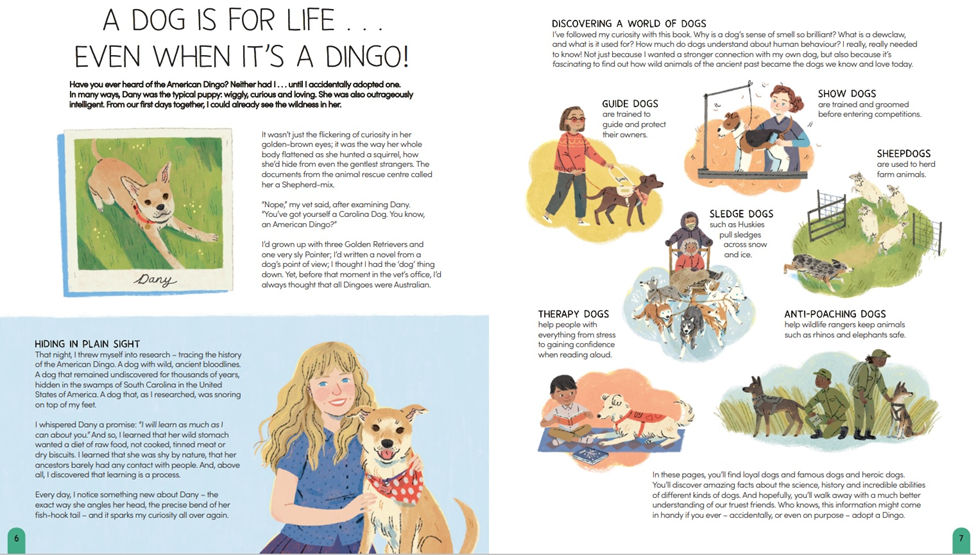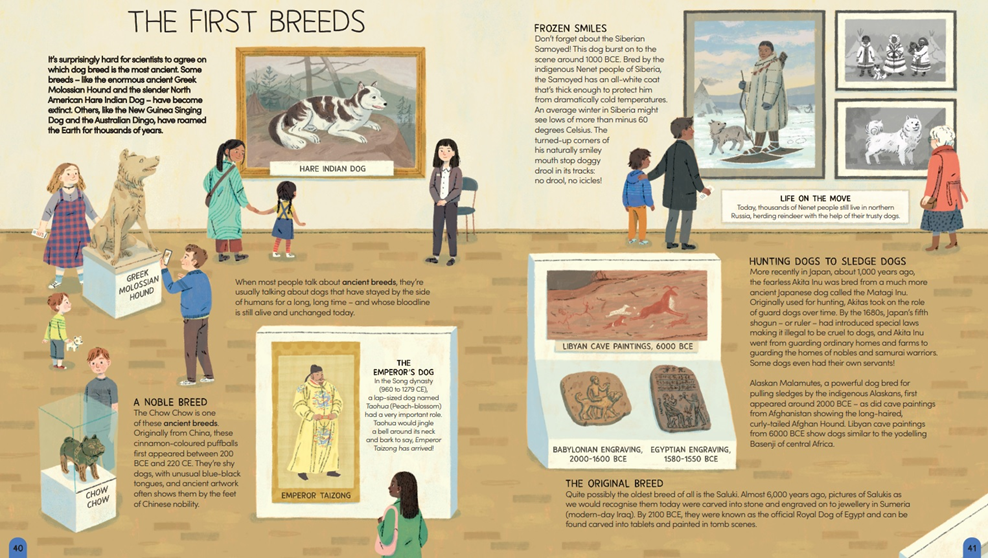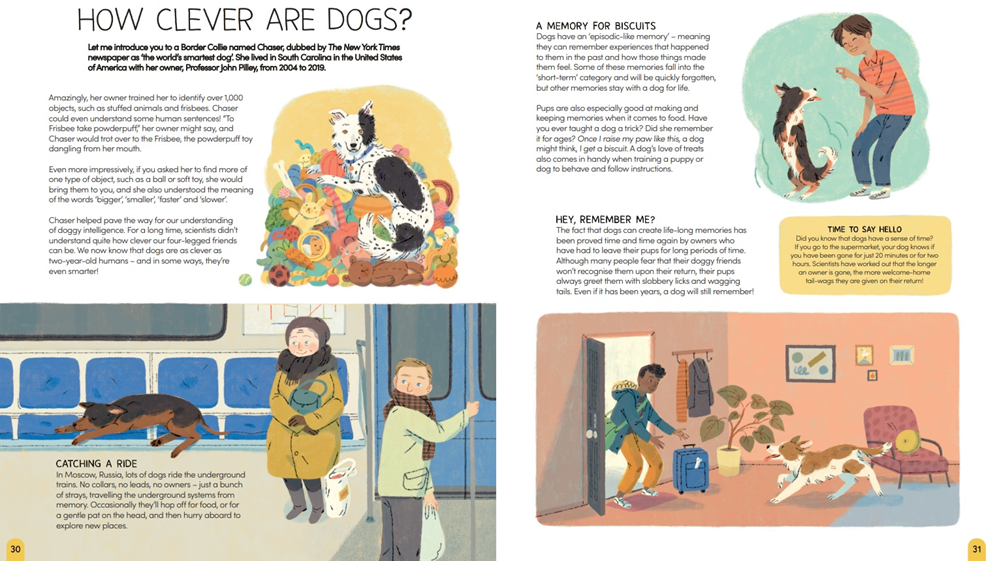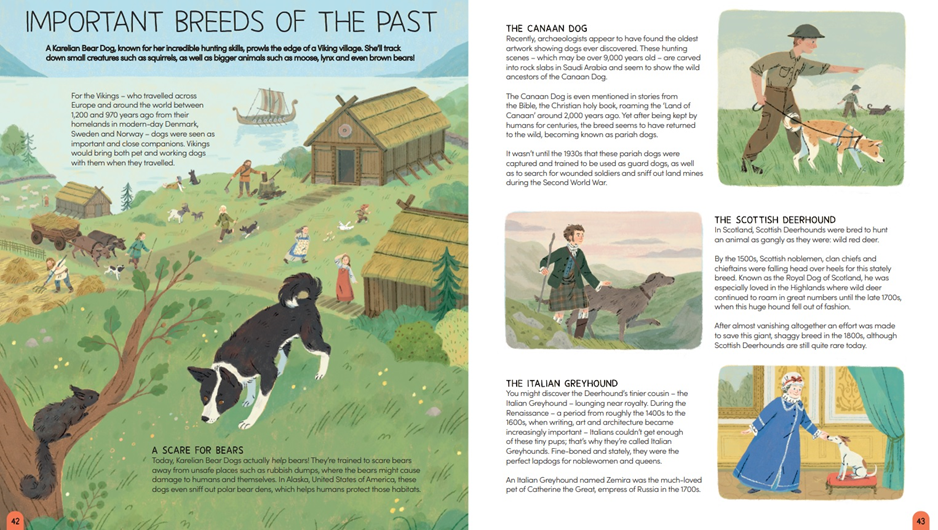Carlie Sorosiak - A World of Dogs


About Author
Carlie Sorosiak lives in Atlanta, Georgia, with her husband and her American Dingo, Dany. A bestselling children's author, her books include I, Cosmo, My Life as a Cat and Always, Clementine. She has a master's in English from Oxford University and another in publishing. She wrote this book in honour of every dog she's ever loved.
Luisa Uribe is an illustrator and designer. She graduated as a graphic designer from the National University of Colombia and has an MA in Art and Design from Loughborough University. Recent publications include Your Name is a Song, My Town/Mi Pueblo and My Brother Is Away. She lives in Bogotá, Colombia with her partner and two cats.
Interview
A World of Dogs (Nosy Crow)
September 2023
If you have ever wondered how good a dog's hearing really is, why dogs spend so long 'sniffing', and why there are so many different kinds of dogs, then reach out for a copy of A World Of Dogs: A Celebration of Fascinating Facts and Amazing Real-Life Stories for Dog Lovers.
The book, written by Carlie Sorosiak and illustrated by Luisa Uribe, boasts a huge range of information, from the history of dogs to why we like to cuddle them, and will be poured over by readers young and old.
A World of Dogs 5* reviews: 'There is so much respect and care shown for dogs in this book ... that it is sure to be as fascinating for those who know little about dogs as it is for those who share their lives with them.
Q&A with Carlie Sorosiak
"When we cuddle with dogs, we release oxytocin - the love hormone - which is the same hormone that
releases when people cuddle with their human babies."
1. Hi Carlie, thank you for joining us on ReadingZone! Can you please tell us about your own experiences with dogs - in real life and in your fiction? And what, or who, are your favourite dogs?
Dogs have always been my best friends. Growing up, my family had a very sly German shorthaired pointer named Sally, and a happy-go-lucky golden retriever called Ralph (who served as the inspiration for Cosmo in my middle-grade novel, I, Cosmo). Now, I'm extremely blessed to have an American Dingo in my life! Her name is Dany, and she's my soul dog.
I tend to write dogs into most, if not all, of my books! After I, Cosmo, I wrote a picture book called Everywhere with You, illustrated by Devon Holzwarth, inspired by my experience of reading to Sally over the fence between our houses (she was, originally, our neighbour's dog).
2. Did these pets help inspire you to write your new non-fiction guide about dogs for children, A World of Dogs?
Yes! You can say that I'm dog obsessed. I wanted to share just how brilliant our canine companions are. There's so much to learn about dogs - they're wonderfully complex animals, with interesting internal lives.

3. Have you written other non-fiction books? How did you approach this project?
A few years ago, I wrote a non-fiction book called Roar Like a Lion: How Animals Can Help You Be Your Best Self. It's jam-packed with advice from all over the animal kingdom, on topics like friendship and being yourself. I really loved writing that - engaging with all sorts of animals, from platypuses to wombats - and there were a few dogs in there, too!
With A World of Dogs, I worked heavily with my wonderful editor Rachel, at Nosy Crow, to shape the book into sections. We had a big brainstorming session, where we wrote down a bunch of questions - everything we've ever wanted to know about canines. The book answers those questions in a fun way!
4. Why do you go so far back into the history and evolution of dogs, and where did you find this out?
I think it's important to know where dogs came from, just as it's important to know where we came from. Our histories and dogs' histories are invariably linked. For research, I watched a lot of documentaries and read a lot of articles from places like the Smithsonian, which made my heart - and my brain - happy.
5. What were your favourite research sources?
National Geographic offers a wealth of information. I loved them as a kid, and I love them now. Scientific American is a close second for me.
6. What are your top three canine facts and biggest surprises about dogs?
Oh, it's so hard to choose! Almost every fact about dogs has the ability to wow you. So, I'm just going to pick the first three that pop into my head.
• There was once a Collie-mix named Bobbie who travelled over 4,000 kilometres - on foot, by himself, without a map - to reunite with his human family.
• Dogs dedicate 40 percent more of their brains to decoding smells than humans! That's part of the reason why their sniffers are so magnificent.
• When we cuddle with dogs, we release oxytocin - the love hormone - which is the same hormone that releases when people cuddle with their human babies.
During my research, the thing that surprised me the most about dogs was: dogs actually rely on the Earth's magnetic fields to poo! That's why they circle around so much before popping a squat. A little gross, but incredible!
7. Having created this guide, what are your top tips for writing great non-fiction?
Pick a topic that you're already obsessed with (because you'll be spending a lot of time with the subject!). Take meticulous note of your sources. And allow the research to surprise you! Don't outline so rigidly that there's no wiggle room for serendipity.
8. What did you think when you saw the illustrations by Luisa Uribe? Any favourites?
I was absolutely blown away. Luisa captures such a range of doggy expressions and joys. I'm a little biased, but I cried when I saw the illustrations of my American dingo, Dany! Other favourite spreads include 'The First Breeds' and 'Rarely Seen Dogs.' But really, it's very difficult to pick! They all have a special magic.

9. Are you planning any more non-fiction - perhaps a guide to cats?
Yes! I'm currently working on a companion book to A World of Dogs called - you guessed it - A World of Cats. We're just finishing up the first round of edits now, and I can't wait to see the illustrations (also by Luisa!) soon. On top of that, I'm drafting my second adult novel, under the pen name Carlie Walker, which will be out in 2024.
10. What does the life of an author look like for you? What are your favourite, and least favourite, things about being an author?
Every day is a little different! As I'm typing this, I'm currently on a writing retreat in Saint Simons Island, Georgia - about five hours from where I live in the United States. Today, I'll be drafting a novel on the porch of a beach house, and taking some breaks to walk my dingo on the sand. Some days, I'm editing back home in my office; others, I'm brainstorming in my car while listening to music. It really depends!
My least favourite thing about being an author - currently - is deadlines. I'm seven months' pregnant at the moment, and finding it a little difficult to keep up! Luckily, my editors and publishers have been extremely gracious, and I'm super thankful for that.
My favourite thing is getting to write about subjects I'm extremely passionate about. Twelve-year-old Carlie would be over the moon to find out that someone actually commissioned her to write about dogs!
Find out more about Carlie Sorosiak's fiction for children

Q&A with Luisa Uribe
1. What inspired you to become a children's books illustrator? Do you enjoy illustrating fiction as well as non-fiction?
Books were my favorite thing when I was growing up, and I remember being mesmerized by the images in them. I've always loved to draw and paint but it wasn't obvious at first that Illustration was a path I could take, so I was a graphic designer for a while - and still am a little bit. Eventually, after many years of doing a bit of everything, the path opened and it was like coming back home.
I find joy in both fiction and non-fiction books. I love that fiction gives you freedom to be creative with your characters and setting, so it's more open in a sense. With non-fiction, you usually start by doing research, and I end up with these huge libraries of hundreds of images and items which is so much fun; it's always a chance to learn about many different topics, some of which wouldn't have crossed my path otherwise.
2. How did you get involved in illustrating A World of Dogs, and what excited you - and challenged you - about the project?
I got involved in illustrating A World of Dogs through my agent at the Bright Agency. The project excited me because it meant drawing and researching the looks, history, and behavior of SO many dogs, and now I know so much about them. The challenging part was that of course I ended up drawing hundreds of dogs, which is a lot! I am a lot better at dog anatomy now, which is great.
I love animals, and I remember some of my favorite books when I was little were these kind of books; I think eight-year-old me would have been thrilled by A World of Dogs (as current me is!), so it truly was a privilege to be a part of it.

3. Where did you start, given how much is covered in the text?
There really was so much to show! Carlie's text is really a feat. Thankfully the lovely team at Nosy Crow had most of the initial layout already figured out so I could start by thinking about the individual scenes. Also, the project was managed in stages, so I just had to worry about a bit at a time.
4. Where did you go to research how the dogs look, especially in the section about the evolution of dogs?
I thankfully had some references from Nosy Crow, who had a clear idea of how they wanted things to look, and I used that as my starting point. For the evolution section, I looked for paleo art - like in the case of Miacis - that was current and relevant. However, there is always a degree of assumption since the evidence for some things like coloration and markings is limited, so I tried to consider that and make it realistic.
For the dogs in general, I (like the rest of the team) had the classic Dog Encyclopedia that has examples of hundreds of breeds, which was beyond helpful! I also liked to look at dog show videos like Crufts and Westminster, and agility videos, which helped me with capturing each dog's expression and movement.
5. How did you decide on the style of illustration?
I always try to give each book I make its own look within the limits of my style and ability, so for this book I wanted something distinct. I wanted to try working with flatter shapes and black linework, so I incorporated that which I think gave the images a fresh look.
I work in Photoshop for the most part. Depending on the feeling of the book I'll add analog and hand drawn textures for character, but from sketch to final color it's mostly done on the computer, drawing directly on a pen display.
6. What about organizing the spreads and deciding on how the spreads would look? Any favorites?
It was tricky since some spreads had many different scenes that had to play well with each other, so I think having a limited palette and cohesive style helped to unify each spread, and balancing the negative space was also crucial.
I think my favorite is Important Breeds of the Past (p. 42-43), I really enjoyed drawing a Viking village and all the little people working in the background, the big dog in the foreground smelling a black squirrel, there's a lot going on! But every spread had its fun moments.

7. Do you do other kinds of illustration work?
For now I'm mostly focusing on picture books, but I've done book covers, middle grade books, editorial and I was even Art director for a Colombian TV show for kids a while ago. Right now, I'm working on a book called 'Under Anna's Umbrella', written by Amanda Driscoll and published by Rocky Pond Books. It's a sad and sweet and lovely book and I'm really excited about it. And of course, getting ready to tackle A World of Cats!
I work from home, I'm a 99% digital artist so I do my work directly on the computer. I have a small studio that I share with my partner and his fly fishing workshop, so it's half picture book collection and desk with screens and half traditional desk with lots of fly materials and fishing stuff. It's a bit chaotic but we make it work.
8. Which illustrators inspire you the most? Any current favourite books?
Oh, so many books and illustrators! I'm leaving so much out but: Very appropriately I am obsessed with Hot Dog by Doug Salati, which was the Caldecott medal winner this year. I just love his linework and characters, and that little dog! I'm also a fan of Laurent Moreau's books, his humor and flat imagery is lovely. Sydney Smith's book Small in the City is incredible, Carson Ellis is amazing, Yas Imamura, etc. I also love the work of many Colombian illustrators, but this is getting long so I'll just mention a few: Leo Espinosa, Paola Escobar, Lorena Álvarez, Santiago Guevara… There are so many incredible illustrators around right now, it's inspiring.

 A World of Dogs: A Celebration of Fascinating Facts and Amazing Real-Life Stories for Dog Lovers
A World of Dogs: A Celebration of Fascinating Facts and Amazing Real-Life Stories for Dog Lovers
